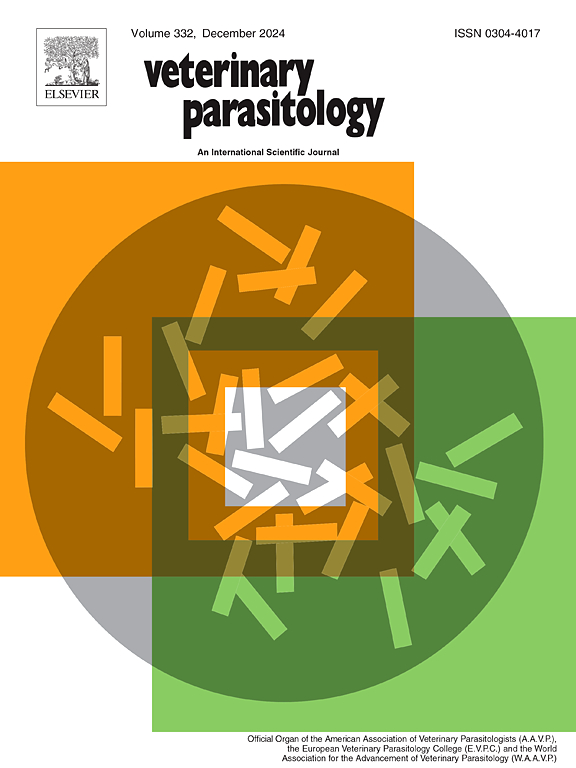The influence of the dung beetle Copris incertus on dung removal and gastrointestinal nematode density on pasture
IF 2
2区 农林科学
Q2 PARASITOLOGY
引用次数: 0
Abstract
Gastrointestinal nematodes (GIN) are considered of major importance by livestock farmers, with burdens limiting production. Dung beetles have been reported to reduce GIN numbers by direct damage during ingestion, increasing aeration and desiccation in the dung pat, and moving dung deeper into the soil. This study investigates the impact of differing densities of the paracoprid dung beetle, Copris incertus, on GIN across different seasons in New Zealand. Treatments of different dung beetle abundances (Control, Low, Medium and High) were applied in field enclosures during four-week periods in spring, summer and autumn. A Natural treatment, with no enclosure to allow unrestricted colonisation of the dung, was included in summer and autumn. Dung pats containing nematode eggs were applied to all plots. In both spring and autumn there was increased dung removal at the highest dung beetle abundances. In spring the increased removal of dung from the soil surface was associated with more buried dung balls and an increase in the number of infective larvae stage 3 (L3) numbers in the herbage in the High dung beetle treatment. There was no evidence that Copris incertus reduced nematode larval numbers on pasture, regardless of beetle densities.
粪甲虫(Copris incertus)对牧场粪清除和胃肠道线虫密度的影响
胃肠道线虫(GIN)被家畜养殖户认为是重要的,其负担限制了生产。据报道,屎壳郎通过在摄入过程中直接破坏、增加粪便部位的通气和干燥以及将粪便移至更深的土壤中来减少GIN的数量。本研究调查了不同密度的粪甲虫(Copris incertus)在新西兰不同季节对GIN的影响。在春、夏、秋4周的野外围场中,分别采用对照、低、中、高4种不同的屎壳虫丰度处理。在夏季和秋季进行自然处理,没有围栏,允许粪便无限制地定植。所有小区均施用含有线虫卵的粪块。在春秋两季,屎壳虫丰度最高时,粪清除量增加。春季,高屎壳虫处理牧草粪球掩埋量增加,粪球掩埋量增加,3期感染幼虫数量增加。没有证据表明,无论甲虫密度如何,无尾草都能减少草地上线虫幼虫的数量。
本文章由计算机程序翻译,如有差异,请以英文原文为准。
求助全文
约1分钟内获得全文
求助全文
来源期刊

Veterinary parasitology
农林科学-寄生虫学
CiteScore
5.30
自引率
7.70%
发文量
126
审稿时长
36 days
期刊介绍:
The journal Veterinary Parasitology has an open access mirror journal,Veterinary Parasitology: X, sharing the same aims and scope, editorial team, submission system and rigorous peer review.
This journal is concerned with those aspects of helminthology, protozoology and entomology which are of interest to animal health investigators, veterinary practitioners and others with a special interest in parasitology. Papers of the highest quality dealing with all aspects of disease prevention, pathology, treatment, epidemiology, and control of parasites in all domesticated animals, fall within the scope of the journal. Papers of geographically limited (local) interest which are not of interest to an international audience will not be accepted. Authors who submit papers based on local data will need to indicate why their paper is relevant to a broader readership.
Parasitological studies on laboratory animals fall within the scope of the journal only if they provide a reasonably close model of a disease of domestic animals. Additionally the journal will consider papers relating to wildlife species where they may act as disease reservoirs to domestic animals, or as a zoonotic reservoir. Case studies considered to be unique or of specific interest to the journal, will also be considered on occasions at the Editors'' discretion. Papers dealing exclusively with the taxonomy of parasites do not fall within the scope of the journal.
 求助内容:
求助内容: 应助结果提醒方式:
应助结果提醒方式:


